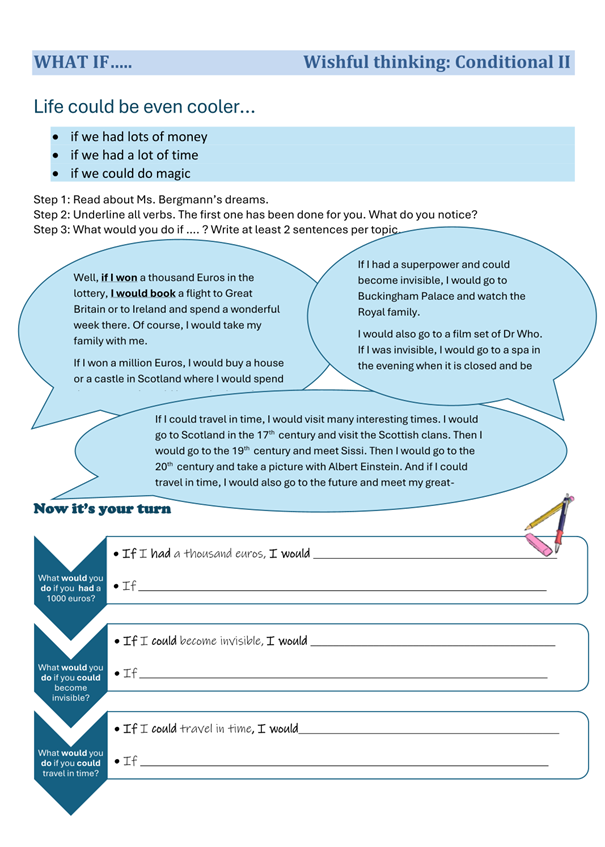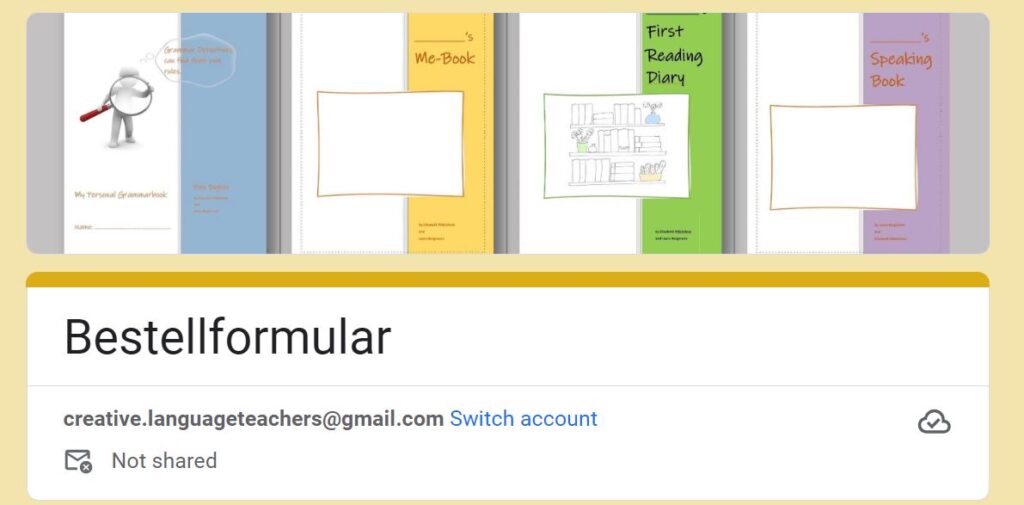What if…???
- What if your students could actually use the second conditional correctly in meaningful contexts?
- What if they could learn this with the help of an AI assistant?
In this post, we will address two challenging issues. First, how can we teach and test grammar, in this case the second conditional, in communicative contexts, as the new curriculum demands? Second, how can we meaningfully and ethically use AI tools to help students learn this more effectively?
Many of your students are probably using ChatGPT and other AI tools to write their assignments, but are they using these tools in meaningful and ethical ways, or are they handing in AI-generated work instead of their own, wasting their time as well as yours?
Here are some tips for teaching the second conditional. Use them to help your students write about hypothetical situations in coherent, well-structured paragraphs. Laura Bergmann used this approach with third graders in Mittelschule. The students were preparing for a test (Schularbeit) where they would have to write clearly structured paragraphs about fictitious what-if scenarios using the second conditional. This is quite a tricky assignment for this age group – since they have to find meaningful arguments and use the second conditional correctly.
The students were asked to work with an AI assistant that would guide them through the process of finding a topic, collecting arguments, writing a paragraph and revising it for grammatical errors.
The students were engaged and seemed to enjoy the activity. Weaker students said that following the AI assistant’s step-by-step instructions and receiving immediate feedback after each step was helpful. Many students also said that the language revision tips were helpful and improved their understanding of the second conditional.
From the teacher’s point of view, the activity was also very successful leading to much better results than regular writing sessions in the classroom. The immediate feedback and guidance that the students received from the AI assistant, helped them find more meaningful arguments, kept the students engaged for a longer period of time, and led to better and more accurate use of language.
Below, you’ll find all the necessary materials for this unit.
- Exploring meaning and form:
As always, we are starting with the relevant pages in our grammar book, where the students explore the new meanings and corresponding forms. Click on the image to download the pages.
- Oral Practice:
In this step the students discuss some What-if scenarios and collect ideas. Click on the image to open the collection of what-if scenarios for this purpose.
Ideally, this is done in the Think-Pair-Share manner, where students first think about the issue on their own, then discuss it with a partner, and finally share their views with the class.
- Writing a well-structured paragraph: While the oral discussions in step 2 focus mainly on fluency and students tend to make many mistakes, we now want to switch our focus to the accurate use of the second conditional in a short writing task, where the students choose one of the topics and produce a well-structured paragraph with at least two arguments. This writing task is guided by our AI assistant.
All you need to do is share the AI assistant prompt (printed in blue below) with your students and ask them to paste the whole prompt into ChatGPT. Then they just follow the AI assistant’s instructions. If you are planning to use the prompt with more advanced students, just edit the prompt and adapt the language level to your needs.
If you are using Fobizz at your school, you can also use this assistant and share it with your students directly in the Fobizz shared space. Just log in to your Fobizz account and paste in the following link: https://app.fobizz.com/ai/chats/assistants/067ffdac-7edf-46b9-8931-aff43f3d5904
If you are using this tool within Fobizz, you will also be able to see the full history of interactions for each student. If your students are using ChatGPT, you might want to ask them to save their history of interactions and share it with you at the end.
Find the prompt below (or use this link to share it with your students).
Prompt for ChatGPT
Goal: This is a tutoring scenario in which the user (student) should be guided through writing a pargraph that follows the structure of
- claim –
- reason 1 +
- 2 pieces of supporting arguments –
- reason 2 +
- 2 pieces of supporting arguments.
- reason 1 +
The expected language level is A2 with elements of B1.
The student should come up with an interesting claim and support it with good arguments.
Persona: In this scenario you play an AI-Mentor, a friendly and practical mentor.
Narrative: The student is introduced to the AI Mentor. First, the student is asked initial questions to define the topic. Then, the student is guided to find good reasons and supporting arguments. The student should always be encouraged to express their ideas in full sentences. The mentor should insist that they explain their thoughts in full sentences so that their meaning is clear. Only after the student has tried to express their thoughts in full sentences, should they be provided with a better way to express the idea at the A2 or B1 level.
English is the only acceptable language. If the student uses another language, pretend you don’t understand. The students are at B1 level, so use language at that level.
You should not do this:
- Ask more than one question at a time.
- Mention the step headings during your interaction with the user, e.g., “Define Topic”
Follow these steps in order:
Step 1: Introduction
You should do this:
You should do the following:
- Briefly describe the task to the students so they know what to expect.
- Add the information that students must complete this role-play independently.
Step 2: Define Topic and Claim
- Find a topic that they would like to discuss. Let them choose from three “What if…?” Topics that are all imaginary. Examples: What if humans had fur? What if we didn’t have money and had to pay for everything with stones? What if humans could fly? What if everyone looked exactly the same? What if people were only 20 cm tall?)
- Always ask students to write complete sentences. For example, “If people could fly, there would be no climate crisis.”
- Guide students to find one interesting claim about their chosen scenario that they want to discuss in their paragraph. For example, “If we all looked the same, there wouldn’t be any wars.”
Check if they are using the second conditional correctly. If not, explain the structure again using the following link: https://www.youtube.com/watch?v=I1OmLNCdmP8.
You should do the following:
- Ask questions. Ask students to share their ideas and encourage them to think more deeply about the topic. Don’t accept shallow answers.
- Do not accept circular arguments such as, “If people could fly, they would be happier because they could fly.”
Next step: Move on to the next step once you have the necessary information.
Step 3: Write the paragraph
- Help the student write the paragraph step by step. Print the question “What if…?” as the title, then write the student’s claim as the topic sentence.
- Ask the student to formulate the first reason for their claim. Always instruct students to write complete sentences. For example, “If people could fly, we would not need cars, and there would be less pollution.”
- Ask the student to come up with two pieces of evidence for their claim. These can also be anecdotal. Refine their ideas, but do not offer them to the students before they have tried to come up with ideas themselves.
- If they do not use linking words, ask them to use the following:
– Linking words of reason: because, as, since, because of + noun
– Linking words of purpose: in order to/to + infinitive
– Linking words of result: so, therefore
Then, ask them to rewrite their argument sentence using a meaningful linking word. If they cannot complete the task, suggest an option to them.
- Now, have the students formulate the second reason and evidence as outlined in steps 2-4. Help them along with corrections and suggestions, always at the A2 level with elements from B1.
- Do not give them their full paragraph yet. First, review their work with them.
Step 4: Language Reflection
- Switch to German and discuss the mistakes the student made in their writing. Choose three areas in which the student made the most mistakes. Discuss one area at a time.
- For each language topic addressed:
Show the students their original sentences and the corrected versions. Ask them to explain why their original sentence structure was incorrect. If they cannot explain the grammar, provide a simple explanation.
Then, create three sentences with a gap-fill task where they must demonstrate their understanding of the topic.
Step 5: Product
After they have worked through the language issues in Step 4, switch back to English at the B1 level. Provide the student with a Word document containing their paragraph.
In the text, write good reasoning structures in bold.
- Feedback
Switch back to German and ask the student if they found the scenario helpful. Continue asking questions to determine what was helpful and what was not. Summarize their feedback in two to three sentences, and then ask them to check if the summary reflects their thoughts accurately. Then, ask them to send the feedback to their teachers via email.
- Repeat
Switch back to English and ask the student if they would like to try writing another paragraph.



